check engine RENAULT ESPACE 2012 J81 / 4.G Owners Manual
[x] Cancel search | Manufacturer: RENAULT, Model Year: 2012, Model line: ESPACE, Model: RENAULT ESPACE 2012 J81 / 4.GPages: 267, PDF Size: 8.95 MB
Page 35 of 267
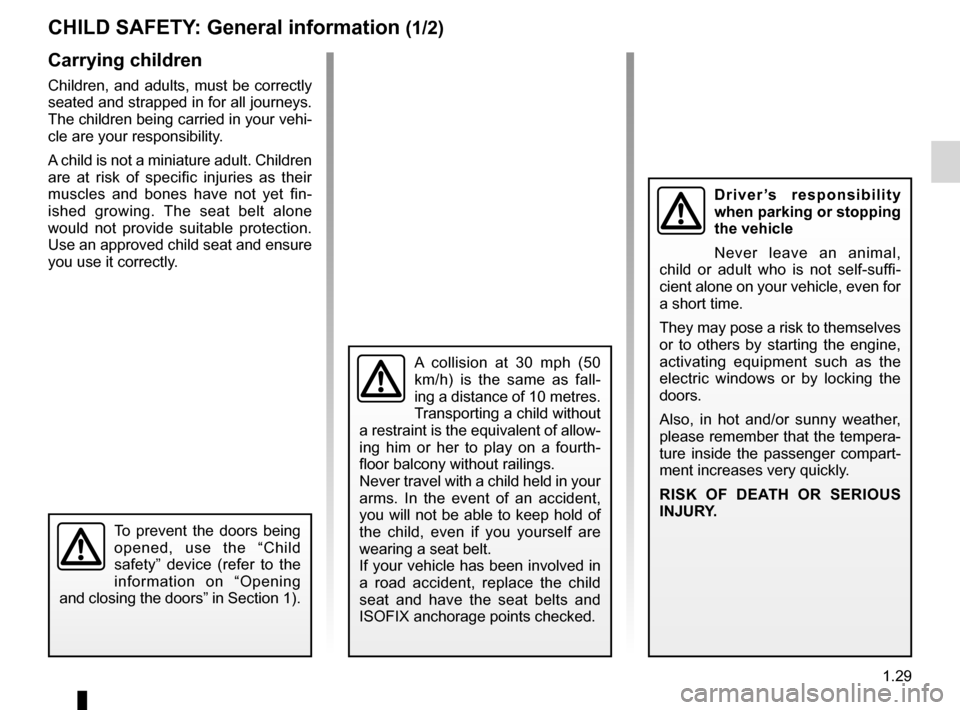
child safety............................................ (up to the end of the DU)
child restraint/seat ................................ (up to the end of the DU)
child restraint/seat ................................ (up to the end of the DU)
child restraint/seat ................................ (up to the end of the DU)
child seats ............................................. (up to the end of the DU)
transporting children ............................. (up to the end of the DU)
children ................................................. (up to the end of the DU)
1.29
ENG_UD18356_1
Sécurité enfants : généralités (X45 - H45 - L38 - X38 - \
X32 - Renault)
ENG_NU_932-3_X81ph3_Renault_1
Child safety: General information
cHILd safeTY : General information (1/2)
carrying children
Children, and adults, must be correctly
seated and strapped in for all journeys.
The children being carried in your vehi-
cle are your responsibility.
A child is not a miniature adult. Children
are at risk of specific injuries as their
muscles and bones have not yet fin -
ished growing. The seat belt alone
would not provide suitable protection.
Use an approved child seat and ensure
you use it correctly.
A collision at 30 mph (50
km/h) is the same as fall -
ing a distance of 10 metres.
Transporting a child without
a restraint is the equivalent of allow -
ing him or her to play on a fourth -
floor balcony without railings.
Never travel with a child held in your
arms. In the event of an accident,
you will not be able to keep hold of
the child, even if you yourself are
wearing a seat belt.
If your vehicle has been involved in
a road accident, replace the child
seat and have the seat belts and
ISOFIX anchorage points checked.
To prevent the doors being
opened, use the “Child
safety” device (refer to the
information on “Opening
and closing the doors” in Section 1).
d r i v e r ’s r e s p o n s i b i l i t y
when parking or stopping
the vehicle
Never leave an animal,
child or adult who is not self-suffi -
cient alone on your vehicle, even for
a short time.
They may pose a risk to themselves
or to others by starting the engine,
activating equipment such as the
electric windows or by locking the
doors.
Also, in hot and/or sunny weather,
please remember that the tempera-
ture inside the passenger compart-
ment increases very quickly.
r Is K O f dea TH O r ser IOUs
InJUr Y.
Page 53 of 267
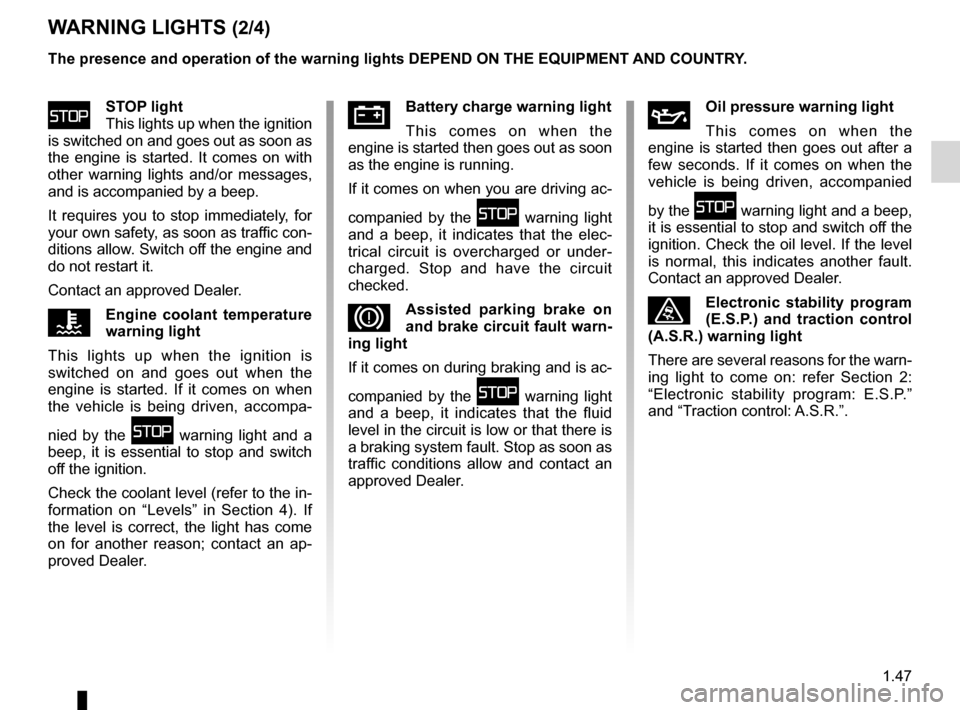
ASR (traction control) ............................................ (current page)
ESP: Electronic Stability Program ......................... (current page)
parking brake ......................................................... (current page)
engine oil ............................................................... (current page)
JauneNoirNoir texte
1.47
ENG_UD20346_1
Tableau de bord : témoins lumineux (X81 - J81 - Renault)
ENG_NU_932-3_X81ph3_Renault_1
WarnInG LIGHTs (2/4)
ûsTOP light
This lights up when the ignition
is switched on and goes out as soon as
the engine is started. It comes on with
other warning lights and/or messages,
and is accompanied by a beep.
It requires you to stop immediately, for
your own safety, as soon as traffic con-
ditions allow. Switch off the engine and
do not restart it.
Contact an approved Dealer.
Ôe ngine coolant temperature
warning light
This lights up when the ignition is
switched on and goes out when the
engine is started. If it comes on when
the vehicle is being driven, accompa -
nied by the
û warning light and a
beep, it is essential to stop and switch
off the ignition.
Check the coolant level (refer to the in-
formation on “Levels” in Section 4). If
the level is correct, the light has come
on for another reason; contact an ap -
proved Dealer.
ÀOil pressure warning light
This comes on when the
engine is started then goes out after a
few seconds. If it comes on when the
vehicle is being driven, accompanied
by the
û warning light and a beep,
it is essential to stop and switch off the
ignition. Check the oil level. If the level
is normal, this indicates another fault.
Contact an approved Dealer.
ùe lectronic stability program
( e .s .P.) and traction control
(a.s.r.) warning light
There are several reasons for the warn-
ing light to come on: refer Section 2:
“Electronic stability program: E.S.P.”
and “Traction control: A.S.R.”.
ÚBattery charge warning light
This comes on when the
engine is started then goes out as soon
as the engine is running.
If it comes on when you are driving ac-
companied by the
û warning light
and a beep, it indicates that the elec -
trical circuit is overcharged or under -
charged. Stop and have the circuit
checked.
Da ssisted parking brake on
and brake circuit fault warn-
ing light
If it comes on during braking and is ac-
companied by the
û warning light
and a beep, it indicates that the fluid
level in the circuit is low or that there is
a braking system fault. Stop as soon as
traffic conditions allow and contact an
approved Dealer.
The presence and operation of the warning lights dePend On THe eQUIPMenT
and cOUnTrY.
Page 67 of 267
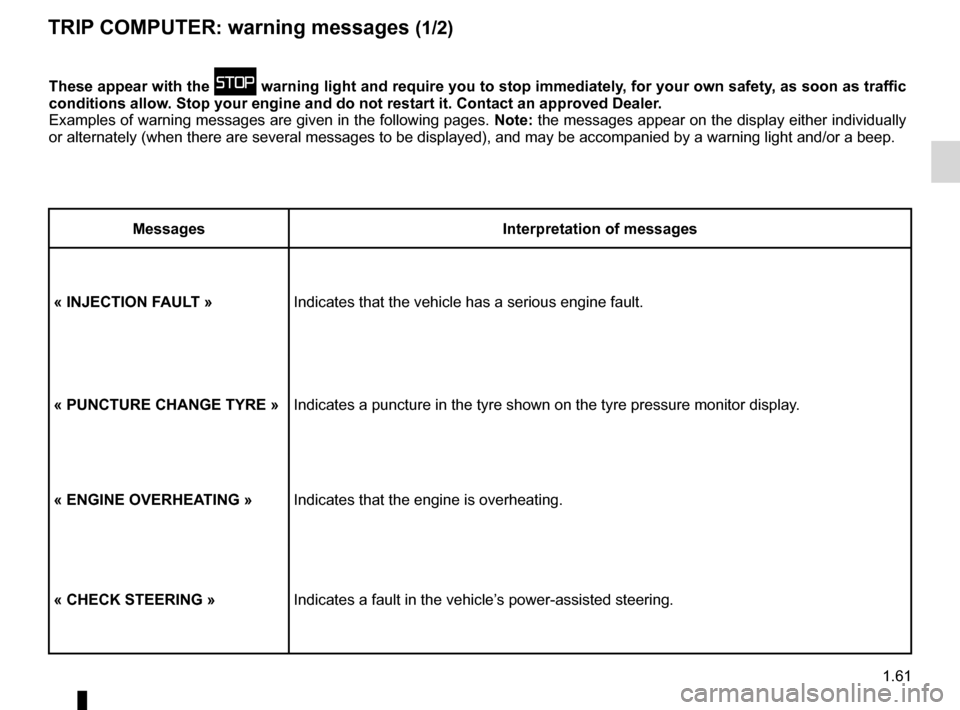
1.61
ENG_UD24102_1
Ordinateur de bord : messages d’alerte (X81 - J81 - Renault)
ENG_NU_932-3_X81ph3_Renault_1
TrIP cOMPUTer: warning messages (1/2)
These appear with the û warning light and require you to stop immediately, for your own safety, as soon as traffic
conditions allow. stop your engine and do not restart it. contact an approved dealer.
Examples of warning messages are given in the following pages. note: the messages appear on the display either individually
or alternately (when there are several messages to be displayed), and \
may be accompanied by a warning light and/or a beep.
Messages Interpretation of messages
« InJecTIOn faULT » Indicates that the vehicle has a serious engine fault.
« PUncTUre cHanGe TYre »Indicates a puncture in the tyre shown on the tyre pressure monitor disp\
lay.
« enGIne OVerHea TInG »Indicates that the engine is overheating.
« cHecK sTeerInG » Indicates a fault in the vehicle’s power-assisted steering.
Page 86 of 267
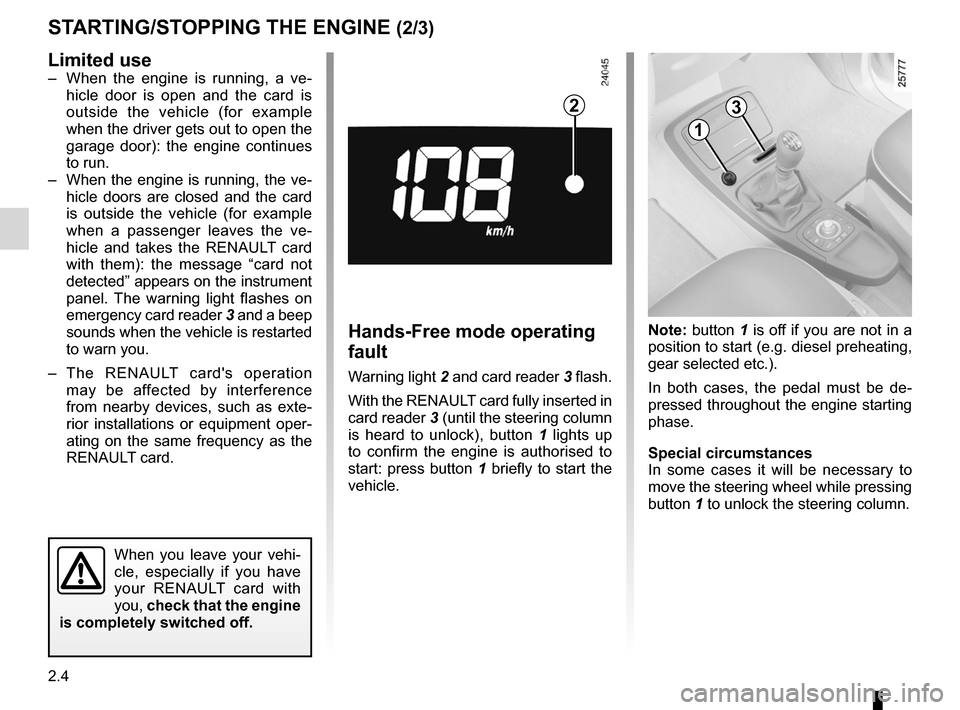
2.4
ENG_UD25550_3
Démarrage/arrêt moteur avec carte RENAULT mains libres (X81 - J81 - Renault)
ENG_NU_932-3_X81ph3_Renault_2
Jaune NoirNoir texte
STARTING/STOPPING THE ENGINE (2/3)
Limited use
– When the engine is running, a ve -
hicle door is open and the card is
outside the vehicle (for example
when the driver gets out to open the
garage door): the engine continues
to run.
– When the engine is running, the ve-
hicle doors are closed and the card
is outside the vehicle (for example
when a passenger leaves the ve -
hicle and takes the RENAULT card
with them): the message “card not
detected” appears on the instrument
panel. The warning light flashes on
emergency card reader 3 and a beep
sounds when the vehicle is restarted
to warn you.
– The RENAULT card's operation
may be affected by interference
from nearby devices, such as exte -
rior installations or equipment oper -
ating on the same frequency as the
RENAULT card.
When you leave your vehi -
cle, especially if you have
your RENAULT card with
you, check that the engine
is completely switched off.
Hands-Free mode operating
fault
Warning light 2 and card reader 3 flash.
With the RENAULT card fully inserted in
card reader 3 (until the steering column
is heard to unlock), button 1 lights up
to confirm the engine is authorised to
start: press button 1 briefly to start the
vehicle. Note: button
1 is off if you are not in a
position to start (e.g. diesel preheating,
gear selected etc.).
In both cases, the pedal must be de -
pressed throughout the engine starting
phase.
Special circumstances
In some cases it will be necessary to
move the steering wheel while pressing
button 1 to unlock the steering column.
23
1
Page 87 of 267
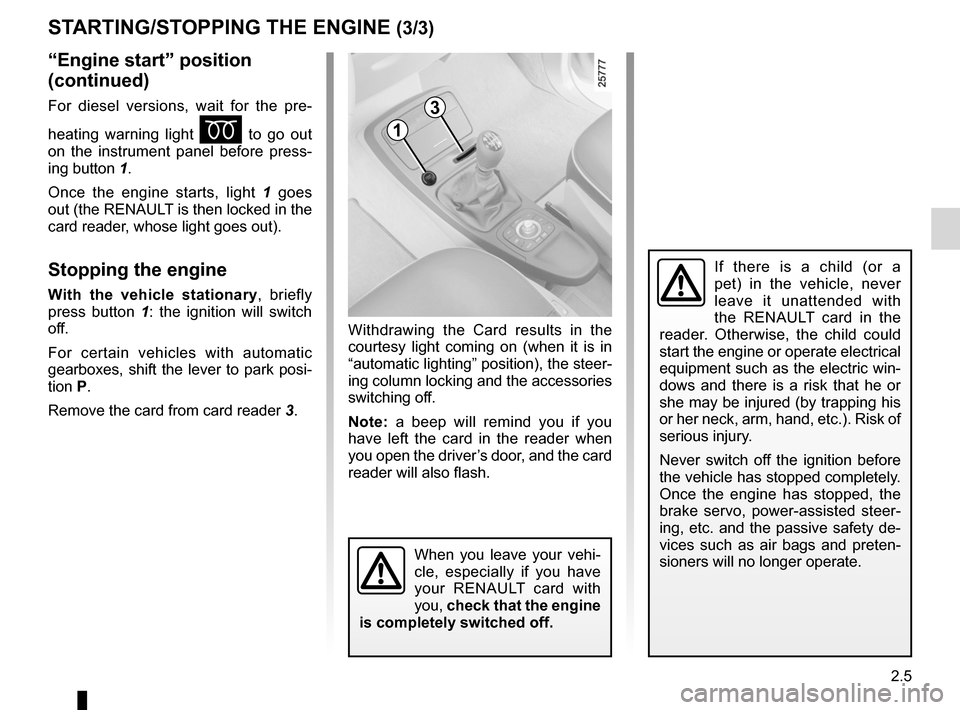
JauneNoirNoir texte
2.5
ENG_UD25550_3
Démarrage/arrêt moteur avec carte RENAULT mains libres (X81 - J81 - Renault)
ENG_NU_932-3_X81ph3_Renault_2
3
1
STARTING/STOPPING THE ENGINE (3/3)
“Engine start” position
(continued)
For diesel versions, wait for the pre -
heating warning light
É to go out
on the instrument panel before press -
ing button 1.
Once the engine starts, light 1 goes
out (the RENAULT is then locked in the
card reader, whose light goes out).
Stopping the engine
With the vehicle stationary , briefly
press button 1 : the ignition will switch
off.
For certain vehicles with automatic
gearboxes, shift the lever to park posi-
tion P.
Remove the card from card reader 3.Withdrawing the Card results in the
courtesy light coming on (when it is in
“automatic lighting” position), the steer-
ing column locking and the accessories
switching off.
Note:
a beep will remind you if you
have left the card in the reader when
you open the driver’s door, and the card
reader will also flash.
When you leave your vehi -
cle, especially if you have
your RENAULT card with
you, check that the engine
is completely switched off.
If there is a child (or a
pet) in the vehicle, never
leave it unattended with
the RENAULT card in the
reader. Otherwise, the child could
start the engine or operate electrical
equipment such as the electric win-
dows and there is a risk that he or
she may be injured (by trapping his
or her neck, arm, hand, etc.). Risk of
serious injury.
Never switch off the ignition before
the vehicle has stopped completely.
Once the engine has stopped, the
brake servo, power-assisted steer -
ing, etc. and the passive safety de-
vices such as air bags and preten -
sioners will no longer operate.
Page 89 of 267
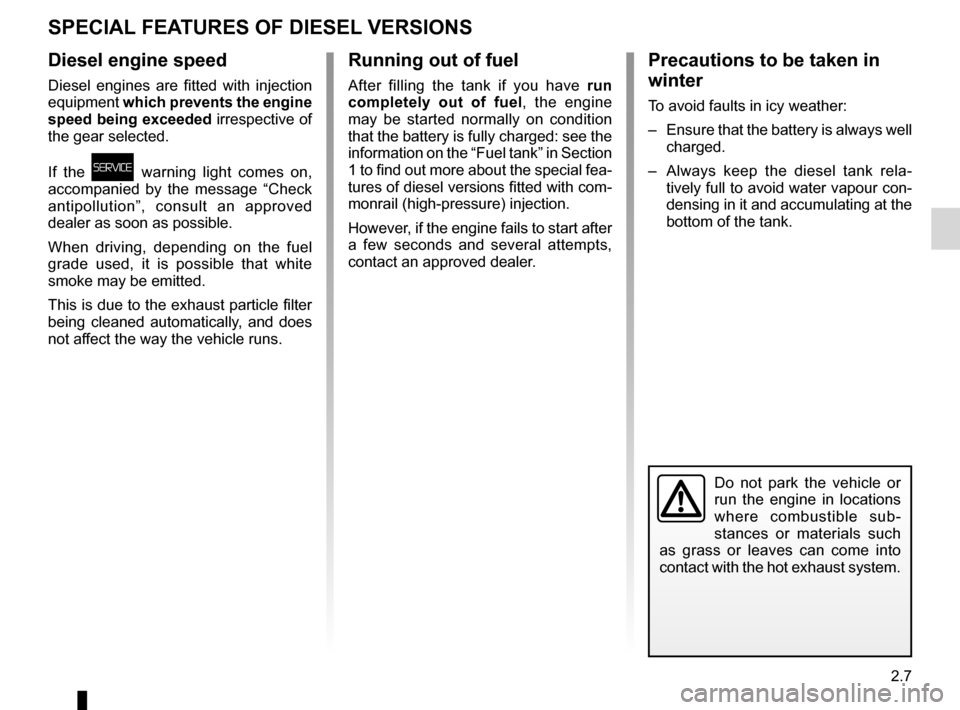
driving ................................................... (up to the end of the DU)
special features of diesel versions ........(up to the end of the DU)
2.7
ENG_UD20364_1
Particularités versions diesel (X81 - J81 - Renault)
ENG_NU_932-3_X81ph3_Renault_2
Special features of diesel versions
SPEcIAL FEATURES OF DIESEL vERSIONS
Diesel engine speed
Diesel engines are fitted with injection
equipment which prevents the engine
speed being exceeded irrespective of
the gear selected.
If the
ú warning light comes on,
accompanied by the message “Check
antipollution”, consult an approved
dealer as soon as possible.
When driving, depending on the fuel
grade used, it is possible that white
smoke may be emitted.
This is due to the exhaust particle filter
being cleaned automatically, and does
not affect the way the vehicle runs.
Precautions to be taken in
winter
To avoid faults in icy weather:
– Ensure that the battery is always well
charged.
– Always keep the diesel tank rela -
tively full to avoid water vapour con-
densing in it and accumulating at the
bottom of the tank.
Do not park the vehicle or
run the engine in locations
where combustible sub -
stances or materials such
as grass or leaves can come into
contact with the hot exhaust system.
Running out of fuel
After filling the tank if you have run
completely out of fuel , the engine
may be started normally on condition
that the battery is fully charged: see the
information on the “Fuel tank” in Section
1 to find out more about the special fea-
tures of diesel versions fitted with com-
monrail (high-pressure) injection.
However, if the engine fails to start after
a few seconds and several attempts,
contact an approved dealer.
Page 90 of 267
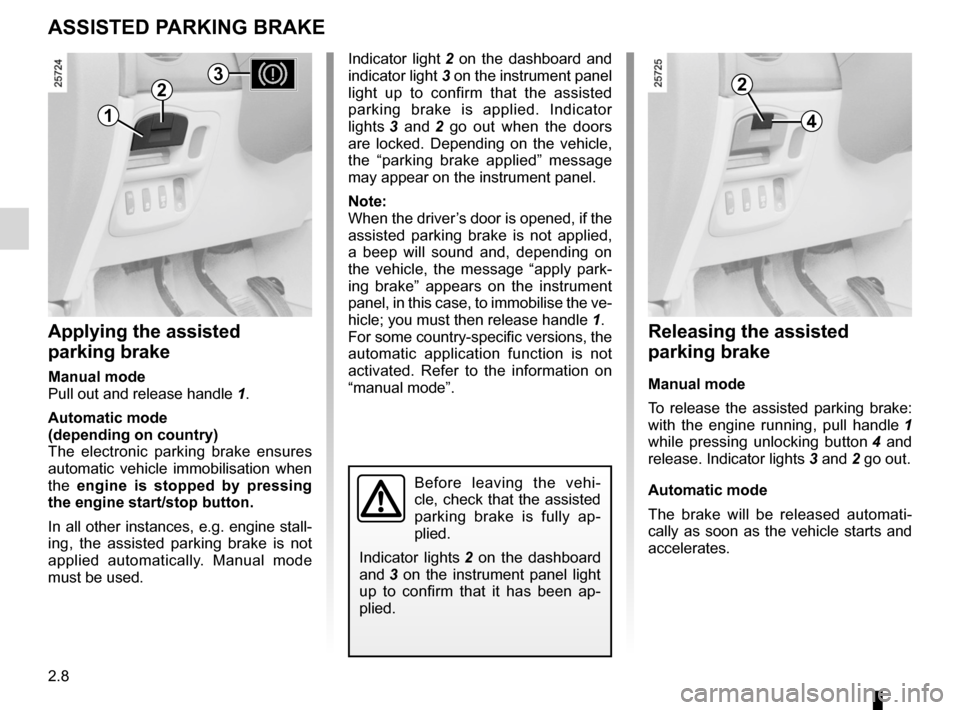
parking brake ........................................ (up to the end of the DU)
driving ................................................... (up to the end of the DU)
2.8
ENG_UD20366_1
Frein de parking assisté (X81 - J81 - Renault)
ENG_NU_932-3_X81ph3_Renault_2
Jaune NoirNoir texte
Electronic parking brake
ASSISTED PARKING BRAKE
Applying the assisted
parking brake
Manual mode
Pull out and release handle 1.
Automatic mode
(depending on country)
The electronic parking brake ensures
automatic vehicle immobilisation when
the engine is stopped by pressing
the engine start/stop button.
In all other instances, e.g. engine stall-
ing, the assisted parking brake is not
applied automatically. Manual mode
must be used.
Indicator light 2 on the dashboard and
indicator light 3 on the instrument panel
light up to confirm that the assisted
parking brake is applied. Indicator
lights 3 and 2 go out when the doors
are locked. Depending on the vehicle,
the “parking brake applied” message
may appear on the instrument panel.
Note:
When the driver’s door is opened, if the
assisted parking brake is not applied,
a beep will sound and, depending on
the vehicle, the message “apply park -
ing brake” appears on the instrument
panel, in this case, to immobilise the ve-
hicle; you must then release handle 1.
For some country-specific versions, the
automatic application function is not
activated. Refer to the information on
“manual mode”.
Releasing the assisted
parking brake
Manual mode
To release the assisted parking brake:
with the engine running, pull handle 1
while pressing unlocking button 4 and
release. Indicator lights 3 and 2 go out.
Automatic mode
The brake will be released automati -
cally as soon as the vehicle starts and
accelerates.
Before leaving the vehi -
cle, check that the assisted
parking brake is fully ap -
plied.
Indicator lights 2 on the dashboard
and 3 on the instrument panel light
up to confirm that it has been ap -
plied.
1
22
4
3
Page 91 of 267
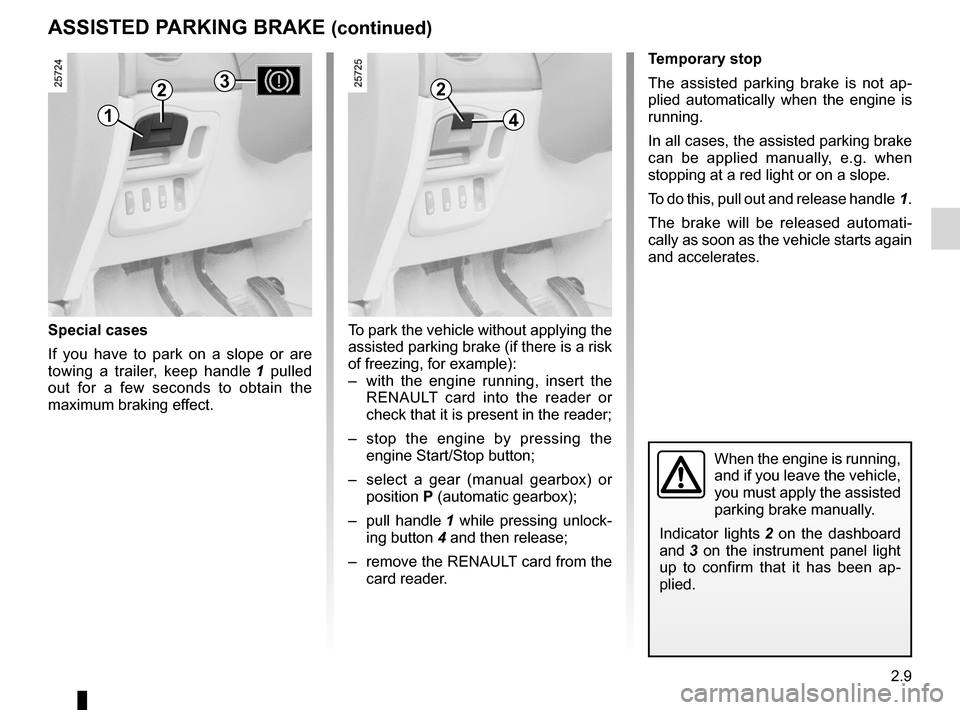
JauneNoirNoir texte
2.9
ENG_UD20366_1
Frein de parking assisté (X81 - J81 - Renault)
ENG_NU_932-3_X81ph3_Renault_2
ASSISTED PARKING BRAKE (continued)
Special cases
If you have to park on a slope or are
towing a trailer, keep handle 1 pulled
out for a few seconds to obtain the
maximum braking effect.
Temporary stop
The assisted parking brake is not ap -
plied automatically when the engine is
running.
In all cases, the assisted parking brake
can be applied manually, e.g. when
stopping at a red light or on a slope.
To do this, pull out and release handle 1.
The brake will be released automati -
cally as soon as the vehicle starts again
and accelerates.
When the engine is running,
and if you leave the vehicle,
you must apply the assisted
parking brake manually.
Indicator lights 2 on the dashboard
and 3 on the instrument panel light
up to confirm that it has been ap -
plied.
To park the vehicle without applying the
assisted parking brake (if there is a risk
of freezing, for example):
– with the engine running, insert the
RENAULT card into the reader or
check that it is present in the reader;
– stop the engine by pressing the
engine Start/Stop button;
– select a gear (manual gearbox) or
position P (automatic gearbox);
– pull handle 1 while pressing unlock-
ing button 4 and then release;
– remove the RENAULT card from the
card reader.
2
41
23
Page 94 of 267
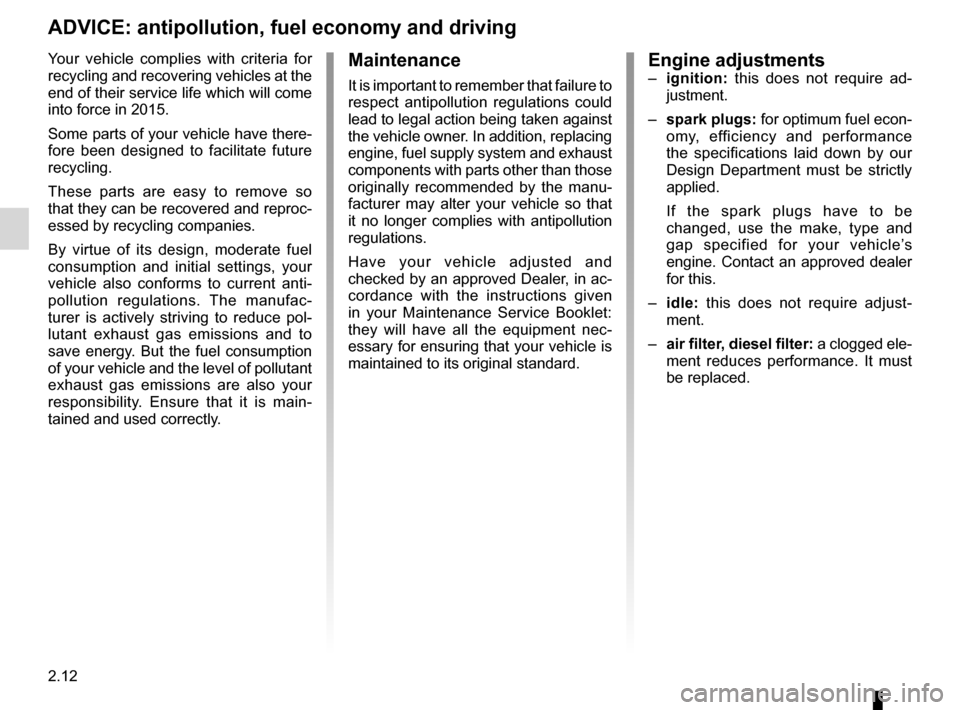
fuel economy ........................................ (up to the end of the DU)
driving ................................................... (up to the end of the DU)
fuel advice on fuel economy .................. (up to the end of the DU)
antipollution advice ............................................. (up to the end of the DU)
advice on antipollution .......................... (up to the end of the DU)
2.12
ENG_UD20368_1
Conseils antipollution, économies de carburant, conduite (X81 - J81 \
- Renault)ENG_NU_932-3_X81ph3_Renault_2
Jaune NoirNoir texte
Advice on antipollution and fuel economy
ADvIcE: antipollution, fuel economy and driving
Maintenance
It is important to remember that failure to
respect antipollution regulations could
lead to legal action being taken against
the vehicle owner. In addition, replacing
engine, fuel supply system and exhaust
components with parts other than those
originally recommended by the manu -
facturer may alter your vehicle so that
it no longer complies with antipollution
regulations.
Have your vehicle adjusted and
checked by an approved Dealer, in ac-
cordance with the instructions given
in your Maintenance Service Booklet:
they will have all the equipment nec -
essary for ensuring that your vehicle is
maintained to its original standard.
Engine adjustments– ignition: this does not require ad -
justment.
– spark plugs: for optimum fuel econ-
omy, efficiency and performance
the specifications laid down by our
Design Department must be strictly
applied.
If the spark plugs have to be
changed, use the make, type and
gap specified for your vehicle’s
engine. Contact an approved dealer
for this.
– idle: this does not require adjust -
ment.
– air filter, diesel filter: a clogged ele-
ment reduces performance. It must
be replaced.
Your vehicle complies with criteria for
recycling and recovering vehicles at the
end of their service life which will come
into force in 2015.
Some parts of your vehicle have there-
fore been designed to facilitate future
recycling.
These parts are easy to remove so
that they can be recovered and reproc-
essed by recycling companies.
By virtue of its design, moderate fuel
consumption and initial settings, your
vehicle also conforms to current anti
-
pollution regulations. The manufac -
turer is actively striving to reduce pol -
lutant exhaust gas emissions and to
save energy. But the fuel consumption
of your vehicle and the level of pollutant
exhaust gas emissions are also your
responsibility. Ensure that it is main -
tained and used correctly.
Page 95 of 267
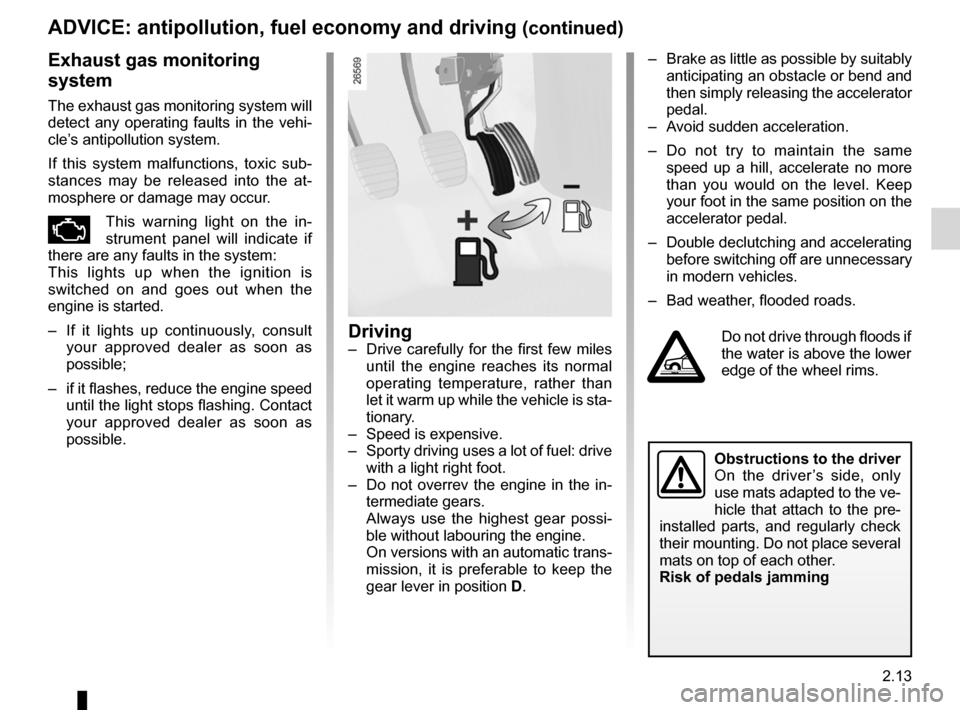
JauneNoirNoir texte
2.13
ENG_UD20368_1
Conseils antipollution, économies de carburant, conduite (X81 - J81 \
- Renault)ENG_NU_932-3_X81ph3_Renault_2
– Brake as little as possible by suitably
anticipating an obstacle or bend and
then simply releasing the accelerator
pedal.
– Avoid sudden acceleration.
– Do not try to maintain the same
speed up a hill, accelerate no more
than you would on the level. Keep
your foot in the same position on the
accelerator pedal.
– Double declutching and accelerating
before switching off are unnecessary
in modern vehicles.
– Bad weather, flooded roads.
ADvIcE: antipollution, fuel economy and driving (continued)
Do not drive through floods if
the water is above the lower
edge of the wheel rims.
Exhaust gas monitoring
system
The exhaust gas monitoring system will
detect any operating faults in the vehi-
cle’s antipollution system.
If this system malfunctions, toxic sub-
stances may be released into the at -
mosphere or damage may occur.
ÄThis warning light on the in -
strument panel will indicate if
there are any faults in the system:
This lights up when the ignition is
switched on and goes out when the
engine is started.
– If it lights up continuously, consult
your approved dealer as soon as
possible;
– if it flashes, reduce the engine speed
until the light stops flashing. Contact
your approved dealer as soon as
possible.
Driving– Drive carefully for the first few miles
until the engine reaches its normal
operating temperature, rather than
let it warm up while the vehicle is sta-
tionary.
– Speed is expensive.
– Sporty driving uses a lot of fuel: drive
with a light right foot.
– Do not overrev the engine in the in-
termediate gears.
Always use the highest gear possi -
ble without labouring the engine.
On versions with an automatic trans-
mission, it is preferable to keep the
gear lever in position D.
Obstructions to the driver
On the driver ’s side, only
use mats adapted to the ve-
hicle that attach to the pre-
installed parts, and regularly check
their mounting. Do not place several
mats on top of each other.
Risk of pedals jamming